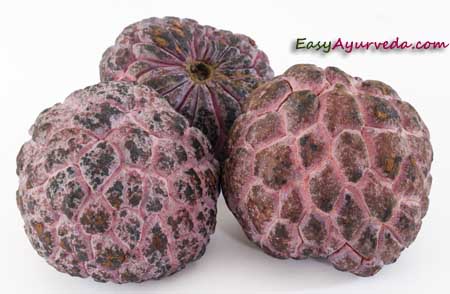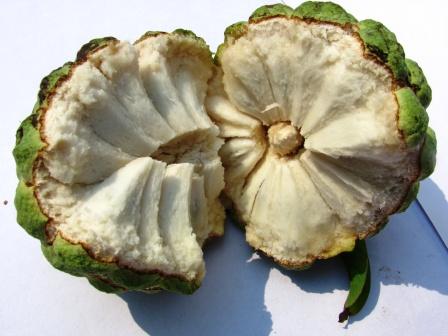Sugar Apple Uses, Research, Remedies, Side Effects
Sitaphala – Annona squamosa is an Ayurvedic plant used for the treatment of diarrhea, ulcers, head lice, skin diseases, strengthens cardiac muscle, acts as expectorant and in the management of diabetes. The fruit of the plant is more popular known as custard apple or Sugar apple.
Latin name – Annona squamosa Linn.
Family – Annonaceae

Table of Contents
Vernacular names
Names in different languages:
Hindi name – Sharifa, Seetaphal
English name – Custard apple, Sugar apple, Sweet sop
Assamese name- Katal
Bengali name- Ata
Kannada name- Seetaphal
Marathi name- Seetaphal
Tamil name- Seetapazham, Cintamaram
Telugu name- Sitaphalamu, Seetapandu
Read related: Sitaphal Annona squamosa Remedies: Aphrodisiac, Head Lice
Sanskrit synonyms
Sanskrit Synonyms of Sitaphala
Krishna beeja- The fruit has black colored seeds
Gandha gatram, Agrimakhya, Atripya
Morphology
Morphology of Annona squamosa:
Seetaphala is a small to medium sized tree growing and cultivated in the temperate climate of India. The tree is a native of West Indies and American continent. The bark of the plant is pale brown in color. The leaves are thin, 10-15 cm long and 2-6 cm wide, rounded at the base and pointed at the tip. The flowers are solitary or in short clusters of 2-4, about 3 cm long and pale green to pale yellow in color. The fruits are round to heart shape, pale green to pale yellow in color and 6-10 cm in diameter. The pulp inside the fruit is pale yellow, sweet and aromatic. The seeds inside the fruit are black and bitter in taste.
Properties, part used, dosage
Medicinal properties of sweet apple:
Rasa (Taste) – Madhura (Sweet)
Guna (Qualities) – Sheeta (Cold)
Vipaka – Madhura (Undergoes sweet taste after digestion)
Veerya (Potency) – Sheeta (Cold)
Karma (Actions) – Vatapitta shamaka (reduces vitiated vata and pitta dosha), Balya (provide strength)
According to Bhojana Kutuhalam, The ripened sitaphala is sweet in taste, cold in potency and helps in treating vitiation of pitta dosha. The ripened fruit improves taste perception and also does not cause excess vitiation of kapha dosha.

Part used- Fruit, Root
Dosage:
Powder- 1 to 3 g
Root decoction- 40 to 50 ml
Fruit pulp- 40 to 50 g
Chemical composition
Chemical composition of Annona squamosa:
The leaf and root of the plant contains squamone and bullatacinone. The root also contains Anoniane, Rocemerine, Norcorydine, Iscocorydine, glaucin etc alkalodis .The leaves contain a cardiotonic alkaloid, quinoline. Seeds of the plant contain annonacin A & annonastatin.
Uses of Sitaphala
- Custard apple is used in desserts, jams, syrups and other cuisines all over the world.
- Root of sitaphala is made into decoction and given in a dose of about 50 ml to treat diarrhea.
- Dried powder of the fruit of Annoina squamosa is used in the treatment of pus filled ulcer. The powder is made into paste by mixing with water and applied over the ulcer for speedy ripening of the ulcer and discharge of the pus from it.
- Paste of the leaf and root of Annoina squamosa is made into paste and applied over the area affected with fungal infection of the skin.
- The fruit pulp acts as tonic for cardiac muscles.
- The decoction of the root is used for head wash to kill head lice.
- Bark of the plant of Annoina squamosa is made into decoction and given in a dose of 40 to 50 ml to control blood sugar level in diabetic patients.
- The powder of the leaf of sitaphala is mixed with honey and given as expectorant to treat patients suffering from cough and dyspnea.
Adverse effects
The seed inside the fruit has abortificant action and hence should not be used by pregnant women.
Interaction with medicines, supplements
Can this be used while taking Homeopathic medicine?
Yes. This product does not react with homeopathic medicine.
Can
this medicine be continued while taking supplements like multivitamin tablets,
Omega 3 fatty acids etc?
Yes. Generally, this product goes well with most
of the dietary supplements. However, if you are taking more than one product
per day, please consult your doctor for an opinion.
With western
medicines
Seek your
doctor’s advice if you are taking this product along with other western
(allopathic / modern) medicines. Some Ayurvedic herbs can interact with modern
medicine.
If both Ayurvedic and allopathic medicines are advised together, then it is
best to take Allopathic medicine first, wait for 30 minutes and then take the
Ayurvedic medicine.
Research articles
Research articles related to Annoina squamosa:
Anti- oxidant activity: The purpose of this paper is to investigate various extracts of Annona squamosa L (Annonanceae) and Carica papaya L (Caricaceae) seeds for their antioxidant activity, free radical scavenging ability, total phenolic and flavonoid contents. Maximum radical scavenging activity (3,201.63 ascorbic acid equivalent antioxidant capacity g/100 g of dry extract) was exerted by water extract of A. squamosa seeds.
Anti- diabetic action: The principle aim of present investigation is to evaluate antidiabetic activity of hydroalcoholic extract of Annona squamosa Linn. in experimentally induced diabetic rat model. Treatment with Annona squamosa extract and Glibenclamide at a dose of 350mg/kg and 5mg/kg respectively for 28 days, after induction of diabetes by Streptozotocin, caused significant reduction in blood serum glucose, lipid profiles like serum cholesterol and triglycerides but significant increase in HDL and body weight in diabetic rats compared to untreated group.
Acaricidal action: The acaricidal activities of crude ethanolic extract of the leaves of Annona squamosa (annonaceae) was assessed against flat larvae and engorged female adults Hyalomma anatolicum using larval (LIT) and adult (AIT) immersion test, respectively. The obtained results indicated that the crude ethanolic extract of A. squamosa at all concentrations used, is toxic to H. anatolicum larvae and adults.
Anti- colitis activity: This study aimed to evaluate the anti-inflammatory effects of Annona squamosa (A. squamosa) leaf aqueous extract against acetic acid induced colitis in rats with a trial to explore its use for the treatment of colon inflammation. Treatment with A. squamosa extract at dose 300 mg/kg for 4 weeks counteracted acetic acid induced ulcerative colitis by a significant decrease (P<0.05) of colonic tissue of malondialdehyde (MDA) and significant increases of catalase (CAT), glutathione (GSH) and glutathione peroxidase (Gpx) compared to ulcerative colitis control group. Furthermore, induction of oxidative stress was observed in the colonic tissue through the levels of 8-hydroxy-2′-deoxyguanosine (8-OHdG) which significant increase in colonic tissue DNA by acetic acid.
Sugar-apples, (sweetsop), raw
Sitaphala in Sanskrit
Taste – sweet
Properties – unctuous
Potency – cold
After digestion taste transformation (Vipaka) – sweet
Effect on Doshas
Vata balancing
Pitta balancing
Kapha increasing
Author: Dr.BK Prashanth M.D (Ayu), Ph.D
E mail: drprashanthbk@gmail.com
Click to consult Dr Prashanth BK









4 comments
Sudha
Thank you doctor for the information on custard apple! At what time of the day we have to take the decoction and for how many days?
Dr J V Hebbar MD(Ayu)Author
10 minutes before food, once or twice a day for 1 month time.
Swapna
Does Sitaphal fruit cause coliky pain ? What should be done if one experiences such pain?
Dr J V Hebbar MD(Ayu)Author
Usually it does not cause such pain.